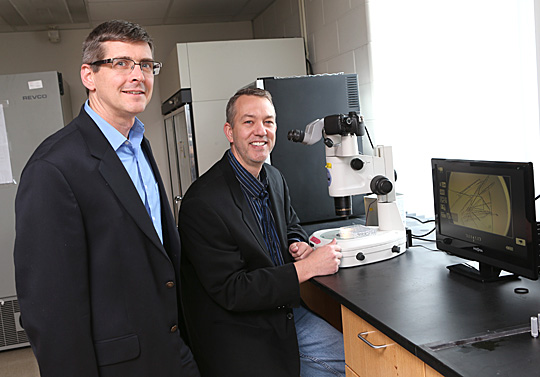Tuberculosis is one of the deadliest diseases caused by an infectious agent. A staggering one-third of the world’s population could be infected with the bacterium Mycobacterium tuberculosis that causes the disease.

Dr. Steve Sucheck, left, and Dr. Donald Ronning are researching a more effective way to treat tuberculosis, thanks to a four-year, $1.5 million grant from the National Institutes of Health.
The world needs a better repertoire of medications to eradicate the TB bacteria, and such efforts start in the chemistry lab.
Dr. Donald Ronning and Dr. Steve Sucheck, associate professors of chemistry at The University of Toledo, recently received a $1.5 million, four-year grant from the National Institutes of Health (NIH) to do just that.
“We started seeing drug resistance to TB in the 1980s, and since then physicians have prescribed a complex cocktail of drugs to effectively treat the illness,” Ronning said. “But with nearly 500,000 new cases of drug-resistant TB every year throughout the world, new drugs are desperately needed.”
TB usually attacks the lungs, but can harm any part of the body. It spreads through the air from one person to another. Symptoms include a severe cough, pain in the chest, coughing up blood, fatigue, chills, fever and weight loss, the last of which led to the old name for TB, “consumption.”
An estimated nine million people had an active TB infection in 2011, resulting in 1.4 million deaths. While the incidence of TB is low in the United States at a rate of 3.2 cases per 100,000 persons, there were still 9,945 TB cases reported in the country in 2012, according to the Centers for Disease Control and Prevention.
Fortunately, not everyone infected with Mycobacterium tuberculosis develops an active TB infection. Most individuals have what is referred to as a latent-TB infection. Those individuals show no symptoms and do not transmit the disease. However, they may develop active TB if their immune system becomes suppressed.
Ronning and Sucheck are focusing their studies on the best ways to treat the bacteria in that population of people with latent-TB infection.
“Current drugs target the actively dividing bacteria, while powerful drugs targeting an enzyme called GlgE could work on both actively dividing and latent bacteria,” Sucheck said.
By studying GlgE, a sugar-transferring enzyme, the researchers are seeking ways to develop new drugs that inhibit the enzyme, thereby causing the accumulation of toxic sugars and leading to a lethal stress response in the bacteria.
The researchers also are studying other possible drug targets that have roles in building the protective outer layer of the bacteria. They have identified new compounds to inhibit these enzymes and are studying their effectiveness using X-ray crystallography, computational screening and chemical synthesis.
By studying and understanding the ways in which the large enzyme molecules interact with the small synthetic compounds, they can identify potential compounds for drug development.
Isoniazid, the first-line medication for TB, was developed in the early 1950s. It is now used with other drugs, commonly rifampin and rifapentine, but 10 drugs have been approved by the U.S. Food and Drug Administration for treating TB.
The current treatment process takes at least six months, and it is important for people with active TB disease to finish the medicine exactly as prescribed. Otherwise, they can become sick again and cause the bacteria to become resistant to those drugs. Treatment of TB caused by drug-resistant strains can take up to three years.
“It is scientific research supported by organizations like the NIH that will lead to the breakthroughs we need to stop the progression of drug resistance and eliminate the threat of death from diseases like TB,” Ronning said.